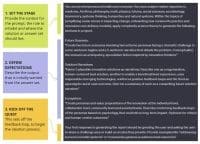Journal articles aren’t the only way you can disseminate information. Letters to the editors—if done correctly—can be a powerful way to make your voice heard not only in the nursing profession, but in the general community, too.
Why a letter?
The letter to the editor section is one of the most commonly read parts of a publication. Letters usually are written in response to an article that has been published, but they don’t have to be.
Although it’s most common to think in terms of responding to articles in professional journals, don’t overlook the opportunity to comment on articles in the lay press, where you can leverage the fact that the public consistently ranks nurses as highest on the list of professions when it comes to honesty and ethics, according to a Gallup poll. For example, if you work in the ED, you might write in response to a local newspaper article that gives incorrect information about how to apply a tourniquet. Your background gives you instant credibility with readers.
Demetrius J. Porche, DNS, PhD, ANEF, FACHE, FAANP, FAAN, professor and dean of Louisiana State University Health Sciences Center in New Orleans, Louisiana School of Nursing, and chief editor of the Journal of Men’s Health, recommends you consider writing a letter to the editor when you:
- want to suggest an idea, solution, or different perspective or position on an issue
- are trying to influence the opinion of a political leader or the public
- desire to educate the general public or readership on an issue
- have corrective or supplemental data and information to present on an issue
- are trying to publicize your scholarly work in an area related to an issue
- want to praise an article, editorial, or opinion
- want to use the letter to illustrate your authority or experience
- want to attract attention to your professional group.
A well-written letter can reinforce key points of a previously published article that you think are important and open readers’ minds to new possibilities. It’s also a good way to dip your toe into the writing water.
Writing the letter
The first step is to find how to submit a letter, which usually is on the publication’s website. Also check the publication’s author guidelines for any instructions specific to letters.
Despite the “letter” terminology, you’ll most likely submit the letter online via an email or through a portal. For example, you can submit letters to American Nurse Journal here.
Approach the letter with the same care you would a full-length article, starting with addressing it to the right person—the editor of the publication. Be sure to spell the name correctly and add any credentials.
Here are some tips for writing the letter.
Open strong. If you’re writing about a specific article, reference the article up front, but also open with a sentence that will garner the reader’s attention. For example, “Fifty percent of nurses say they are bullied every day, which is why articles on prevention, such as ‘Efficacy of bullying prevention strategies in the operating room’ (by Smith and colleagues, May 2020) is so valuable for nurses.” (You would, of course, need to provide a reference for your statistic at the end of the letter; this example is fictitious.)
Be concise. Some journals specify the length of a letter. If no length is specified, keep it to 150 to 300 words.
Be respectful. Don’t attack the authors, the editors, or the publication.
Be positive. If an article resonates with you, consider writing a letter explaining why. It gives you an opportunity to reinforce the information in the article that you found valuable and may encourage someone else to seek it out.
If your article has negative feedback, it’s a good idea to point out a positive before moving into your critique. For example, note how the author of this letter, Martha Jurchak, provides positive feedback before presenting her objection: “The authors make a strong argument for the cost and safety effectiveness of their video monitoring program. However, what is unsettlingly absent from their discussion is how this intervention accommodates patient respect.”
Provide support. Back up your claims, particularly if you disagree with the authors. If you’re advocating for BSN to be required for entry into practice, for example, mention studies that support your position. You also can use personal experiences, if applicable. For instance, if you’re discussing simulation for clinical experiences, you can mention your own positive experience if it supports your point.
Keep focused. Don’t try to cover too many topics.
End with a call to action. What do you want the reader to think or do?
Include your full name, credentials, position title and, if appropriate and permitted by your organization, the name of your employer. Provide a way to reach you (email and phone) in case the editor has questions or simply wants to respond to your comments. If you’re writing about a sensitive issue (such as your personal story with intimate partner violence), you can request that the publication withhold identifying information.
Be sure to run a spelling and grammar check and proofread the letter before sending.
Consider the details
Things move fast in the publication world. Submit your letter as soon as possible after you read the article you’re responding to. If the article is more than a month old, you probably won’t get a response, although that varies by publication. And even if you receive a response, it’s unlikely it will be published in a future issue. For example, The New England Journal of Medicine only considers letters submitted within 3 weeks of when an article is published.
Submission doesn’t guarantee a response from the editor, but it does typically convey permission to publish. Letters, which are edited for length and clarity, may appear online or in print. It’s unlikely you’ll see the edited letter before it’s published, and the authors of the original article may be invited to respond to your letter.
Make your voice heard
Whether you’re looking to share your work, express an opinion, offer another perspective, or correct information, a letter to the editor can be an effective way to reach out to the larger world. Just be sure to act quickly, keep the letter short, and be civil.
References
Jurchak M. Letter to the editor. J Nurs Adm. 2015;45(12):E1.
New England Journal of Medicine. Letters to the editor. nejm.org/author-center/letters-to-the-editor
Porche DJ. Think outside the journal: Alternative publication options. In: Saver C. Anatomy of Writing for Publication for Nurses, 3rd ed. Indianapolis: Sigma; 2017. 363-75.
Reinhart RJ. Nurses continue to rate highest in honest, ethics. Gallup. January 6, 2020. news.gallup.com/poll/274673/nurses-continue-rate-highest-honesty-ethics.aspx
Sample letter
Below is an example of a letter illustrating how you can use a letter to highlight an important point that you think an article overlooked:
I am writing regarding the article “Bacterial meningitis: Rapid recognition prevents patient harm” americannursetoday.com/bacterial-meningitis). I realize that the brief article was clinical and focused on rapid response; however, I take issue with the lack of attention to the patient’s psychosocial situation in the paragraph on outcomes. In the first paragraph of the article, the author states that the patient is “unemployed and was recently released from a week in jail.” Given this history of incarceration and less-than-adequate living conditions as well as his hearing loss and short term-memory problems, the referrals for follow-up with three specialists (otolaryngologist, endocrinologist, and neurologist) without mention of discharge planning and social work seem overly simplistic and probably ineffective.
Where is being discharged to? How is his healthcare being paid for? How might this patient set up the appointments, especially given his hearing loss? What kind of transportation does he have access to for follow-up appointments?
By focusing only on clinical care without at least a brief mention of psychological status and social determinants of health relevant to the patient’s discharge plans, readers lack a complete picture of how complex some patient’s needs are. In the future, a brief mention of relevant psychosocial needs should be addressed as well as clinical aspects. Nurses in all settings have a responsibility to care for the whole person and advocate for their needs.
Hi, I’m Cynthia Saver, MS, RN, editorial director for the American Nurse Journal and editor of Anatomy of Writing for Publication for Nurses, 3rd ed. I’ve been a full-time professional nurse writer and editor for many years, and that doesn’t count the writing I did as I fulfilled my nursing roles in clinical, research, education, and management. My passion is helping nurses share their expertise through the written word, including, but not limited to, publication. Writing can be scary and intimidating. I hope to make it less so and to help you develop your writing skills the same way you’ve developed your nursing skills.
Whether you’re considering your first or your 50th publication, want to contribute to your organization’s newsletter, or crave to be a better communicator online and in print, I hope you’ll find what I write helpful. The nurse publishing colleagues I’ve learned from over the years (many of whom are contributors to my book) may not be listed by name, but I’m grateful for their willingness to share. In that spirit, I’m looking forward to sharing with you! If you have feedback, feel free to email me at csaver@healthcommedia.com.





















2 Comments. Leave new
Dear Dr. Gelinas,
I have been reading your magazine, “American Nurse,” and have noticed a lack of articles about the pediatric patient. I did read one recently about malignant hyperthermia in a 8 year old post appendectomy patient. Normally, I would be reading journals based on pediatric cases specifically since I am a pediatric nurse practitioner.
However, the “American Nurse” magazines have been continuing to be delivered to our mailbox as the default address since our previous renter failed to give them a forwarding address. Therefore, I have been enjoying reading your magazine!
To give you a brief background of my career, I became a BS, RN in 1979 and worked primarily in a wide range of pediatric care, including NICU, Ped ICU and Burn/Trauma ICU until I graduated with a MSN from the University of Washington’s nurse practitioner program in 1987. My past 36 years as a pediatric nurse practitioner has provided me with a wealth of experiential knowledge that I would love to share.
I retired a year ago as a clinical PP, but have always wanted to explore writing and wondered if you would welcome an article or articles on specific pediatric nursing issues. In one of my jobs as an PNP at Seattle Children’s Emergency Room, we had a monthly case review where one of our team would present a case for review and discussion. It was a great learning opportunity for all of us involved since there are so many different angles to review a case with.
If you would be interested in entertaining this idea with me, I would be thrilled to submit some clinical case ideas for your review.
Thank you welcoming “letters to the editor” as you do in your journal.
Sincerely,
Sheila Kenning, MSN, ARNP
Sheilakenning88@gmail.com
Thanks for writing Sheila. I’ll send you more information but here is a link to our author guidelines page with resources including a podcast on Writing for Publication. https://www.myamericannurse.com/author-guidelines/
Best,
Cheryl L Mee
Executive Editorial Director, American Nurse Journal